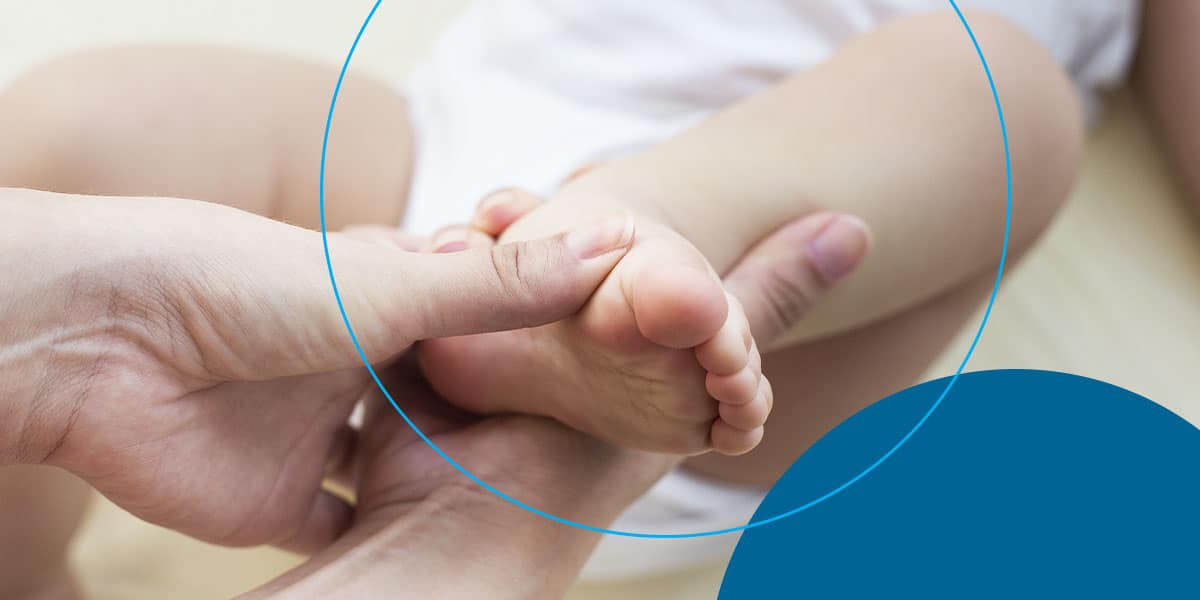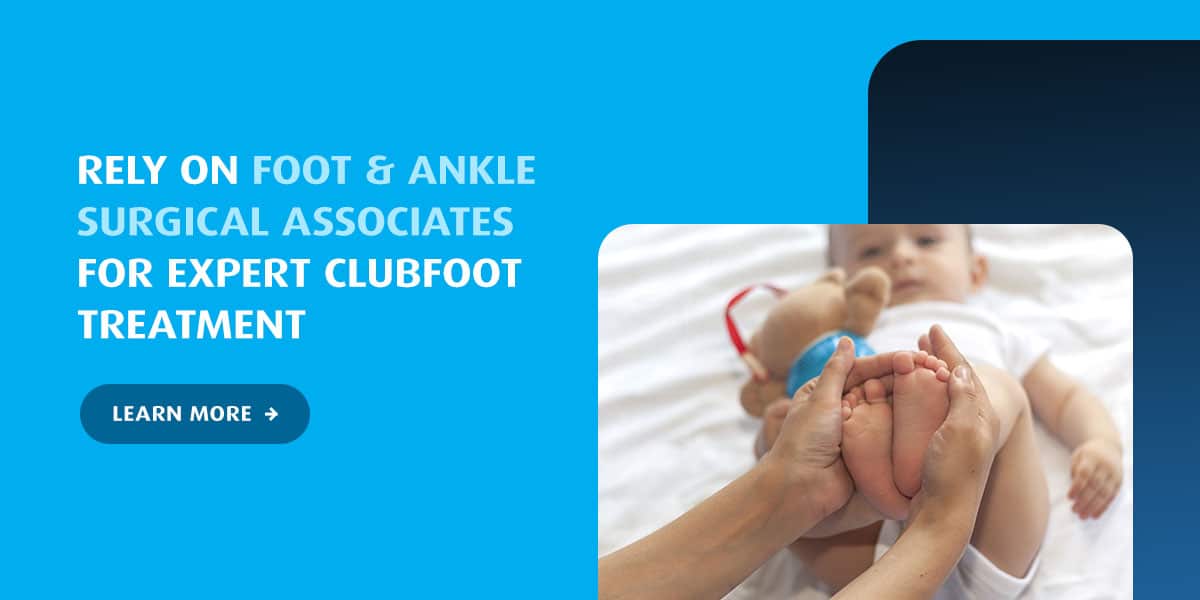
As a parent, you have many aspirations for your child — one is to see them do anything they want with no challenges. While a condition called clubfoot may make walking, playing and doing sports seem impossible, there are many ways to successfully treat clubfoot in infancy, allowing your child to achieve everything you’ve hoped for them. Before learning about different treatment options, you must know the symptoms and causes of clubfoot.
What Is Clubfoot?
Clubfoot is a congenital disability where the foot bones and muscles develop differently in the womb. This formational difference can include differently sized and shaped bones and muscles like a shortened Achilles tendon and smaller calves, causing a more inward foot structure with heels that turn upward or face sideways.
Clubfoot is a common congenital anomaly and occurs in 1.18 in 1,000 births. Additionally, estimates suggest over 176,000 children will be born with clubfoot annually. This condition can affect one or both feet and is more common in boys and firstborn children.
Common types of clubfoot include the following.
- Idiopathic: This clubfoot is the most common type, known as talipes. Out of all the babies with idiopathic clubfoot, half have one clubbed foot and the others have bilateral clubbed feet.
- Neurogenic: An underlying nervous system or neurological condition like spinal bifida or cerebral palsy can cause this type of clubfoot.
- Syndromic: This clubfoot often forms part of other medical conditions due to an underlying syndrome like arthrogryposis.
How Is Clubfoot Diagnosed?
A health professional can diagnose clubfoot during a routine prenatal ultrasound or at birth. Prenatally, nurses and doctors can identify a baby with clubfoot by noticing an inward or upward-facing foot position on an ultrasound.
After a baby is born, clubfoot signs like differently shaped feet can be noticeable, but physicians can confirm the diagnosis after a physical examination. While it can be challenging to learn your baby has clubfoot before birth, early detection can help you prepare for treatment solutions after your baby is born.
What Are the Symptoms of Clubfoot?
Some common clubfoot symptoms can include:
- Shorter Achilles tendon
- Turned in and under foot or feet
- Inward or upward-facing heel
- Misaligned foot and ankle bones
- Shorter leg or foot
- A more profound than a normal arch in a foot
- Smaller or underdeveloped calf muscles
- A deep crease on the bottom of a child’s foot or feet
What Causes Clubfoot?
The cause of clubfoot remains unknown. However, some studies point to genetic and environmental factors like having a male baby or smoking as a common cause of clubfoot. With little to no evidence of the causes of clubfoot, the condition may not be heritable, making it challenging to predict or prevent.
Is Clubfoot Treatable?
A doctor can treat clubfoot after birth and before a baby starts walking. Persistent treatments are necessary for reshaping foot positioning and improving flexibility.
Ponseti
The Ponseti stretching and casting method is one of the most effective techniques for treating clubfoot. The treatment involves your baby wearing a series of casts to reposition their legs and feet to make them more flexible. Here is what you can expect with this approach.
- Two weeks after birth: An orthopedic doctor gently stretches your baby’s feet or foot to move it into a good position before casting.
- Casting: A physician places a cast on your baby’s foot or feet, which spans the length of their toes to their upper thigh. Your baby may wear this cast for up to six weeks.
- Recasting and stretching: Between four and seven weeks, your doctor will gently pull and reposition your baby’s foot, moving it closer to a good position and making it as flexible as possible. Your doctor will then recast your baby’s foot and leg, continuing this method over four to six casts.
- In-clinic procedure: Before your baby’s last casting, your doctor will perform a minor in-clinic procedure to bring the heel up, which is challenging to do with the cast in place. The best solution is to cut the heel cord or Achilles tendon, allowing the foot to come up and move closer into position. This procedure is often quick and painless, involving a tiny cut on your baby’s heel.
- Final casting: After the procedure, your doctor places the last cast on your baby’s feet or foot. They often wear this cast for three weeks before bracing.
Bracing
Bracing is an essential process in treating clubfoot and can help avoid the recurrence of clubfoot later. This method involves your baby wearing a brace to secure their foot and ankle. Initially, your baby must wear the brace for 23 hours daily, reduced to 12 hours a day as your child ages. Bracing can be challenging for your baby, but consistency is crucial with this method.
Surgery
In some cases, surgery after casting and bracing might be necessary, especially if your baby has a severe case of clubfoot. Your doctor will often prescribe surgery before your baby starts walking to avoid side effects like pain when walking as they get older. Surgery can involve lengthening the heel cord or Achilles tendon to correct your baby’s foot positioning and other conditions they might have.
While treatments can be successful for many babies, remember that clubfoot can recur in later years due to various circumstances. Some kids might require additional surgical procedures to reposition their foot or feet.
What Are the Risks of Clubfoot?
Some risk factors for clubfoot can include:
- Your baby is male or a firstborn child.
- You smoked or experienced secondhand smoke while pregnant.
- You or your partner have a family history of clubfoot.
- Your baby might have other congenital conditions related to clubfoot, like spinal bifida.
- There is little amniotic fluid surrounding your baby in the womb during pregnancy.
What Are the Complications?
Often, clubfoot causes no evident pain or disturbance for your baby. Without proper treatment during infancy, complications like difficulty walking and pain can occur as your child starts to walk. Other issues can include:
- Your child develops arthritis.
- Your child can have difficulty walking due to their sideways-facing ankle and walking on their heels, outside their foot or on the ball of their foot.
- They may struggle with poor self-image in later years due to their foot or feet appearance.
- Because your child cannot walk on the soles of their feet, they can have underdeveloped calf muscles, foot calluses and sores on their feet.

With treatment during the postnatal phase, your child can have little to no complications when walking in their older years. Complications might include minor difficulties like less flexibility in the affected foot, an underdeveloped calf muscle or needing a smaller shoe size for the affected foot.
After successful clubfoot treatment, children can often do the same activities as kids born without a clubfoot, like playing, running, dancing and sports.
Rely on Foot & Ankle Surgical Associates for Expert Clubfoot Treatment
With appropriate and expert clubfoot treatment, kids can grow up enjoying all their favorite physical activities without limitation. Neglecting clubfoot treatment during crucial baby years can later impact a child’s mobility and foot structure.
At Foot & Ankle Surgical Associates, we believe a child shouldn’t miss out on playing and socializing due to clubfoot. We offer early clubfoot intervention to help kids walk, play sports and enjoy other physical and daily activities as they age. Our expert specialists can treat congenital clubfoot cases without surgery and are passionate about working with kids and helping them walk and move comfortably.
Contact us online today to schedule a consultation.




